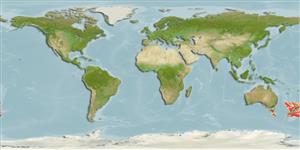Common names from other countries
>
Gadiformes (Cods) >
Macrouridae (Grenadiers or rattails)
Etymology: Coryphaenoides: Greek, koryphaina = dolphin fish + Suffix oides = similar to (Ref. 45335).
More on author: Günther.
Environment: milieu / climate zone / depth range / distribution range
Ecologia
marinhas batidemersal; não migratória; intervalo de profundidade 540 - 2070 m (Ref. 1371). Deep-water; 33°S - 50°S, 137°E - 179°W (Ref. 1371)
Southwest Pacific: New Zealand, Tasman Sea, south of Tasmania, southeast Australia (Victoria), and possibly also across the Indian Ocean (Ref. 1371). A possible subspecies, Coryphaenoides serrulatus oceanus from the Indian Ocean (Walters Shoals south of Madagascar to Broken Ridge in 870-1,255 m) is recognized by Iwamoto and Shcherbachev (Ref. 10993).
Tamanho / Peso / Idade
Maturity: Lm ? range ? - ? cm
Max length : 48.2 cm TL macho/indeterminado; (Ref. 71794)
Espinhos dorsais (total): 2; Espinhos anais 0. Head of moderate-size, its underside scaled; sensory pores on head prominent; eyes relatively large; snout blunt, its tip and lateral angles with large, stout tubercular scutes. Scales adherent, densely covered with distinctly shield-shaped imbricate spinules. Pyloric caeca short, directed anteriorly, 10 to 12; retia mirabilia 6. Overall color is brownish gray; fins dusky; oral and branchial cavities blackish.
A benthic species (Ref. 75154) recorded from the continental slope (Ref. 9563, 75154).
Life cycle and mating behavior
Maturidade | Reprodução | Desova | Ovos | Fecundidade | Larvas
Cohen, D.M., T. Inada, T. Iwamoto and N. Scialabba, 1990. FAO species catalogue. Vol. 10. Gadiform fishes of the world (Order Gadiformes). An annotated and illustrated catalogue of cods, hakes, grenadiers and other gadiform fishes known to date. FAO Fish. Synop. 125(10). Rome: FAO. 442 p. (Ref. 1371)
Categoria na Lista Vermelha da IUCN (Ref. 130435)
CITES (Ref. 128078)
Not Evaluated
Ameaça para o homem
Harmless
Utilização humana
Pescarias: pouco comercial
Mais informação
Nomes comunsSinónimosMetabolismoPredadoresEcotoxicologiaReproduçãoMaturidadeDesovaFecundidadeOvosDesenvolvimento dos ovos
ReferênciasAquaculturaPerfil para aquaculturaEstirpesGenéticaElectrophoresesHereditariedadeDoençasProcessamentoMass conversion
Ferramentas
Relatórios especiais
Descarregue XML
Fontes da internet
Estimates based on models
Preferred temperature (Ref.
115969): 3.1 - 7.2, mean 4.8 (based on 181 cells).
Phylogenetic diversity index (Ref.
82804): PD
50 = 0.5000 [Uniqueness, from 0.5 = low to 2.0 = high].
Bayesian length-weight: a=0.00219 (0.00111 - 0.00431), b=3.20 (3.03 - 3.37), in cm Total Length, based on LWR estimates for this (Sub)family-body shape (Ref.
93245).
Nível Trófico (Ref.
69278): 3.5 ±0.4 se; based on size and trophs of closest relatives
Resiliência (Ref.
120179): Muito baixo, tempo mínimo de duplicação da população maior que 14 anos (Preliminary K or Fecundity.).
Fishing Vulnerability (Ref.
59153): Moderate vulnerability (38 of 100).
